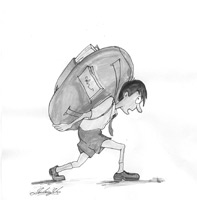Schools charge a hefty monthly fee. But hidden charges continue year long. Gigantic admission fees are paid at every level to discourage students from shifting schools. At the senior level, figures easily cross the six-digit mark. School fees gradually rise with each class and sometimes around the academic year. There is no regulation or standard for any charge in private schools.
Imagine this: a summer and winter vacation is paid for. Many schools don’t pay the teachers during these months. Then why charge the students? Besides, the percentage profit for schools is unidentified. They have no policy or interest in decreasing these expenses for parents.
When the school takes 3 to 4 thousand rupees per child for a bus service, the cost per child is actually far lesser. My school charged a few hundreds bi-annually as examination fee, whereas the sheets we used were less then Rs 50 in total. Some parents complain that their children have one-dish parties where teachers give, and later verify, a long list of food items. One had to buy his son a talking parrot for a school assignment meant to create interest in animals. The whole class was assigned a parrot each. Many schools change branches within six months of enrolling a child. They declare the new branch is now ready and shift the student to the outskirts of Lahore. Students are compelled to buy school copies, which carry the school emblem. Dozens of these copies remain unused. Some make plastic covers compulsory, others only allow school bags of a particular colour or sell badges, coats or other uniform accessories not available anywhere else.
All this waste is generated because schools assume that parents have to pay for their child’s education. Parents fear their child will feel deprived among his/her peers, and continue no matter how taut finances become.
School books are a complicated business. They cost a fortune, are too many in number, never fully taught or re-used by schools. Children are forced to carry heavy bags everyday and they end up complaining of body aches.
A child going in class 1 to 8 requires Rs 6,000 to 10,000 for books, but beyond class 8, they cost a bomb. O and A levels have been around for 20+ years but the books are still imported and worth several thousand each.
Old books are a good choice, but if the book is very recent or the syllabus has been updated, new books are the only option. Sometimes the syllabus is updated mid-year. Books published locally, contain grammatical and factual errors and poor graphics. For example, a book gave a picture of Steffi Graf with the caption, "Man playing tennis".
Curricula need planning to maximise learning and not cram the child with futile information. Some schools now have book charges included in fee. They sometimes provide some or all the books, again charging an unknown share of profit.
The text books need to become more visual, with more pictures, colours, better printing and less text. Most books are structured in a way that adult guidance is necessary and a child cannot independently comprehend it, especially books related to sciences and maths. Information is shoved onto children, with the assumption that English will be grasped and the teacher will form the conceptual base.
It is ironic that schools provide air conditioners but not multimedia and Powerpoint to the teachers. These can offer students visual and auditory assistance; animation can help them understand processes and theories faster, and remember longer. Books should aid a child’s learning, and not be the main source of it.
Why aren’t our schools utilising multimedia to enhance learning, especially when they charge a fortune for tuition?
Writing, for children, is both an art and a craft. Studying from local and imported books is worlds apart. Foreign books are delightful but expensive. They not only develop concepts but make quick re-readings possible. Small columns run in the sidelines, sometimes containing summaries, important facts and diagrams. Some even have cartoon characters, comic strips, short stories and funny comments, and CDs to keep the students interested.
Children lack the concentration span to enjoy thick books. You can attract them for a few minutes longer through images, but can’t drill them with access/unwanted information or blackmail them through results.
According to the British web service Design Shack, children books should be simple not minimalist, easy yet creatively conceptualised, contain elements of luxury like nature, emotions and simple pleasures like balloons, flowers etc and fresh perspectives.
Adeel Niaz, a book designer, says: "Children’s books require bigger fonts, softer colours and familiar images. Or else the child can’t relate to them."
Children are intimidated by difficult books and poor grades. Perhaps this is why the drop-out rate, according to the Pakistan Education Task Force, is the same for private and government schools.
There has to be some association to issue guidelines about children’s course books and publications. Secondly, we need to curtail the usage of foreign books, especially at junior level. The publishing houses should either be located in Pakistan or local publishers should take over. Schools should have similar if not the same curriculum, so that shifting schools isn’t a hassle. Self-publishing should be banned. There should be locker rooms or time-tables. Seniors should sell books or donate their books once they have been promoted. Schools need to come out with schemes of reducing the parental cost and stop sending bills home. One of the chief causes of deforestation is wood which is required to make paper. Re-using, recycling or e-learning will remove this burden on our forests.
Good education is not supposed to be difficult, boring and expensive because this isn’t the case abroad. Above all, education for a child shouldn’t be exploitation for the parents.
This piece was first publsihed in The News in October 2010.

No comments:
Post a Comment